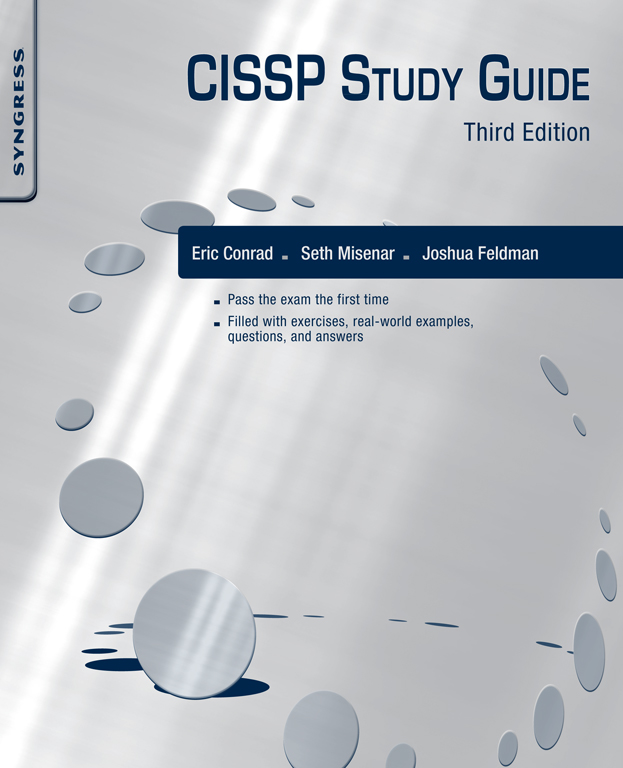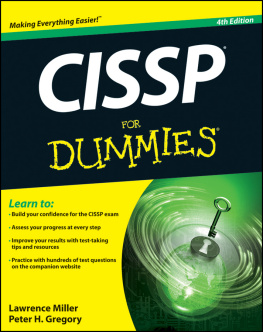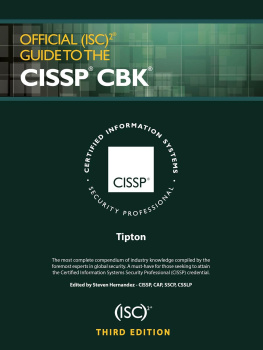Conrad Eric - CISSP Study Guide
Here you can read online Conrad Eric - CISSP Study Guide full text of the book (entire story) in english for free. Download pdf and epub, get meaning, cover and reviews about this ebook. year: 2015, publisher: Elsevier Science, genre: Computer. Description of the work, (preface) as well as reviews are available. Best literature library LitArk.com created for fans of good reading and offers a wide selection of genres:
Romance novel
Science fiction
Adventure
Detective
Science
History
Home and family
Prose
Art
Politics
Computer
Non-fiction
Religion
Business
Children
Humor
Choose a favorite category and find really read worthwhile books. Enjoy immersion in the world of imagination, feel the emotions of the characters or learn something new for yourself, make an fascinating discovery.

- Book:CISSP Study Guide
- Author:
- Publisher:Elsevier Science
- Genre:
- Year:2015
- Rating:3 / 5
- Favourites:Add to favourites
- Your mark:
- 60
- 1
- 2
- 3
- 4
- 5
CISSP Study Guide: summary, description and annotation
We offer to read an annotation, description, summary or preface (depends on what the author of the book "CISSP Study Guide" wrote himself). If you haven't found the necessary information about the book — write in the comments, we will try to find it.
CISSP Study Guide — read online for free the complete book (whole text) full work
Below is the text of the book, divided by pages. System saving the place of the last page read, allows you to conveniently read the book "CISSP Study Guide" online for free, without having to search again every time where you left off. Put a bookmark, and you can go to the page where you finished reading at any time.
Font size:
Interval:
Bookmark:


Acquiring Editor: Chris Katsaropoulos
Editorial Project Manager: Anna Valutkevich
Project Manager: Priya Kumaraguruparan
Designer: Mark Rogers
Syngress is an imprint of Elsevier
225 Wyman Street, Waltham, MA 02451, USA
Copyright 2016, 2012, 2011 Elsevier Inc. All rights reserved.
No part of this publication may be reproduced or transmitted in any form or by any means, electronic or mechanical, including photocopying, recording, or any information storage and retrieval system, without permission in writing from the publisher. Details on how to seek permission, further information about the Publishers permissions policies and our arrangements with organizations such as the Copyright Clearance Center and the Copyright Licensing Agency, can be found at our website: www.elsevier.com/permissions.
This book and the individual contributions contained in it are protected under copyright by the Publisher (other than as may be noted herein).
Notices
British Library Cataloguing-in-Publication Data
A catalogue record for this book is available from the British Library
Library of Congress Cataloging-in-Publication Data
A catalog record for this book is available from the Library of Congress
ISBN: 978-0-12-802437-9

Chapter 9 introduces Domain 8 of the CISSP, Software Development Security. The most important aspects of this domain are related to managing the development of software and applications. Approaches to software development that attempt to reduce the likelihood of defects or flaws are a key topic in this domain. In particular, the Waterfall, Spiral, and Rapid Application Development (RAD) models of the software development are considered. Another significant portion of this chapter is dedicated to understanding the principles of Object Oriented programming and design. A basic discussion of several types of software vulnerabilities and the issues surrounding disclosure of the vulnerabilities are also a topic for this domain. Finally, databases, being a key component of many applications, are considered.
Exam objectives in this chapter
Font size:
Interval:
Bookmark:
Similar books «CISSP Study Guide»
Look at similar books to CISSP Study Guide. We have selected literature similar in name and meaning in the hope of providing readers with more options to find new, interesting, not yet read works.
Discussion, reviews of the book CISSP Study Guide and just readers' own opinions. Leave your comments, write what you think about the work, its meaning or the main characters. Specify what exactly you liked and what you didn't like, and why you think so.



